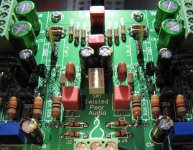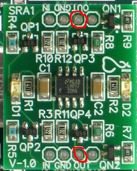looks excellent. this build is an excellent excuse to get out your whackiest looking NOS polypropylene caps  the juxtaposition between high end modern SMD and old world whackiness is superb!! but its all about the sound of course
the juxtaposition between high end modern SMD and old world whackiness is superb!! but its all about the sound of course  anyone looking at possibly using the linear systems stuff? I agree active devices are an excellent opportunity to play with the sound as well. especially in a reasonably simple/elegant circuit, it is a good opportunity to hear the differences in everything really, with such resolution to back it up.
anyone looking at possibly using the linear systems stuff? I agree active devices are an excellent opportunity to play with the sound as well. especially in a reasonably simple/elegant circuit, it is a good opportunity to hear the differences in everything really, with such resolution to back it up.
 anyone looking at possibly using the linear systems stuff? I agree active devices are an excellent opportunity to play with the sound as well. especially in a reasonably simple/elegant circuit, it is a good opportunity to hear the differences in everything really, with such resolution to back it up.
anyone looking at possibly using the linear systems stuff? I agree active devices are an excellent opportunity to play with the sound as well. especially in a reasonably simple/elegant circuit, it is a good opportunity to hear the differences in everything really, with such resolution to back it up.
Last edited:
The trimmers simply set the input bias. Start with them at about mid point.
Measure AVCC at the buffalo II.
Then adjust the pot on each side until the BUF-II outputs are at AVCC/2 (The exact value is not terribly critical so don't sweat it)
It's actually quite an easy project.
Cheers!
Russ
Russ,
Do you mean:
Between + output and GND = AVCC/2 ?
Between - output and GND = AVCC/2 ?
Between + output and - = 0 volt ?
Thanks,
Theodosis
Trimmers adjustments
Russ,
Do you mean:
Between + output and GND = AVCC/2 ?
Between - output and GND = AVCC/2 ?
Between + output and - = 0 volt ?
Thanks,
Theodosis
The trimmers simply set the input bias. Start with them at about mid point.
Measure AVCC at the buffalo II.
Then adjust the pot on each side until the BUF-II outputs are at AVCC/2 (The exact value is not terribly critical so don't sweat it)
It's actually quite an easy project.
Cheers!
Russ
Russ,
Do you mean:
Between + output and GND = AVCC/2 ?
Between - output and GND = AVCC/2 ?
Between + output and - = 0 volt ?
Thanks,
Theodosis
How about transformers instead of boutique caps?
http://www.diyaudio.com/forums/twis...ivy-iii-outputs-buffalo-ii-6.html#post2262852
Film caps instead of electrolitics
Of course I have installed the supplied caps and I am listening to them now.
The question is if I replace these with film caps will be any improvement.
Why not try the supplied el-caps first ?
Of course I have installed the supplied caps and I am listening to them now.
The question is if I replace these with film caps will be any improvement.
Well, I like the appearance of the board. It looking cool.
I even think I'm going to mount it - now!
Nice and tidy build.
If you are going to be listening single-ended, can I suggest that you swap the op-amp you are using for a LME49720HA (the metal can variant). A subtle but worthwhile improvement can be had by doing this. I've found this several times, in headphone amps and also in the ballsie for my B32S.
I'm not saying that caps are BAD. Caps can be compact, inexpensive, and decent sounding.
I simply dislike large and expensive exotic capacitors in this application. IME, a pair of decent transformers are usually cheaper and sound just as good or better.
I'm not saying that caps are BAD. Caps can be compact, inexpensive, and decent sounding.
I simply dislike large and expensive exotic capacitors in this application. IME, a pair of decent transformers are usually cheaper and sound just as good or better.
I think he meant this link: http://www.diyaudio.com/forums/twisted-pear/164294-buffalo-ii-transformers.html
Interesting...
Opinion, chips. I will be running my Legato with Mundorf zN film/foils (running balanced only) these were the best caps I could reasonably fit in my chassis design. I suspect really good caps are more transparent than really good transformers, but this is just a suspicion. Of course transformers also bring something else to the party, as they add distortion (could be pleasing) and they also isolate RF from their output (running balanced should cancel any RF anyway).
I do find it somewhat telling that some of the best preamps in the world (think Audio Research Reference) choose to use caps at the output rather than transformers (likely very expensive teflon films, I believe AR's are "proprietary").
I'm not saying that caps are BAD. Caps can be compact, inexpensive, and decent sounding.
I simply dislike large and expensive exotic capacitors in this application. IME, a pair of decent transformers are usually cheaper and sound just as good or better.
Opinion, chips. I will be running my Legato with Mundorf zN film/foils (running balanced only) these were the best caps I could reasonably fit in my chassis design. I suspect really good caps are more transparent than really good transformers, but this is just a suspicion. Of course transformers also bring something else to the party, as they add distortion (could be pleasing) and they also isolate RF from their output (running balanced should cancel any RF anyway).
I do find it somewhat telling that some of the best preamps in the world (think Audio Research Reference) choose to use caps at the output rather than transformers (likely very expensive teflon films, I believe AR's are "proprietary").
I think he meant this link: http://www.diyaudio.com/forums/twisted-pear/164294-buffalo-ii-transformers.html
Right, maybe that's the link he's referring to. Thanks for pointing that out.
Either way, I prefer to discuss Legato-related topics in the Legato thread
Opinion, chips. I will be running my Legato with Mundorf zN film/foils (running balanced only) these were the best caps I could reasonably fit in my chassis design. I suspect really good caps are more transparent than really good transformers, but this is just a suspicion. Of course transformers also bring something else to the party, as they add distortion (could be pleasing) and they also isolate RF from their output (running balanced should cancel any RF anyway).
I do find it somewhat telling that some of the best preamps in the world (think Audio Research Reference) choose to use caps at the output rather than transformers (likely very expensive teflon films, I believe AR's are "proprietary").
Sorry if I wasn't clear, but I meant IME by my "past" experience with capacitor and transformer coupling.
Though I suspect that the transformers will remain my favorite, I do intend to compare them against Muse ES bipolars and Mundorf SGOs when I receive my Legato
- Home
- More Vendors...
- Twisted Pear
- Legato or IVY III outputs for Buffalo II?

